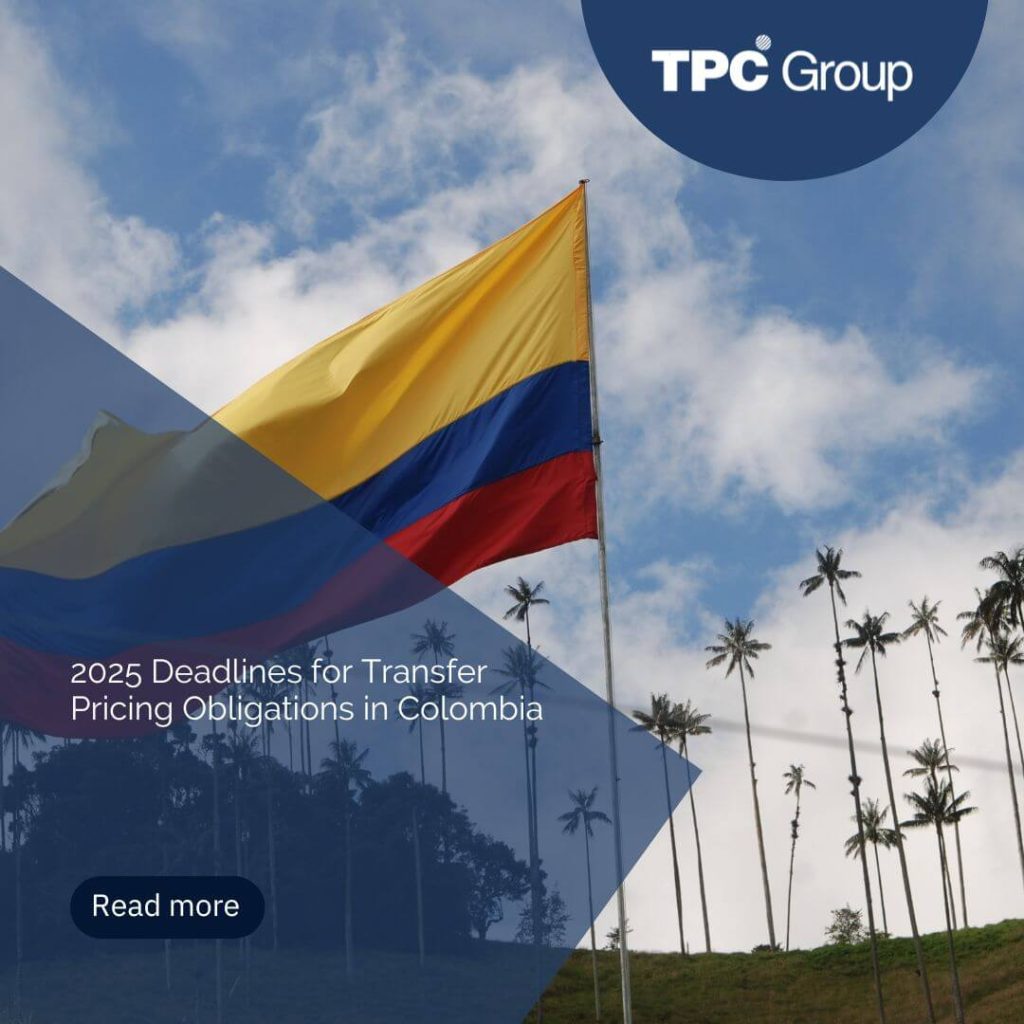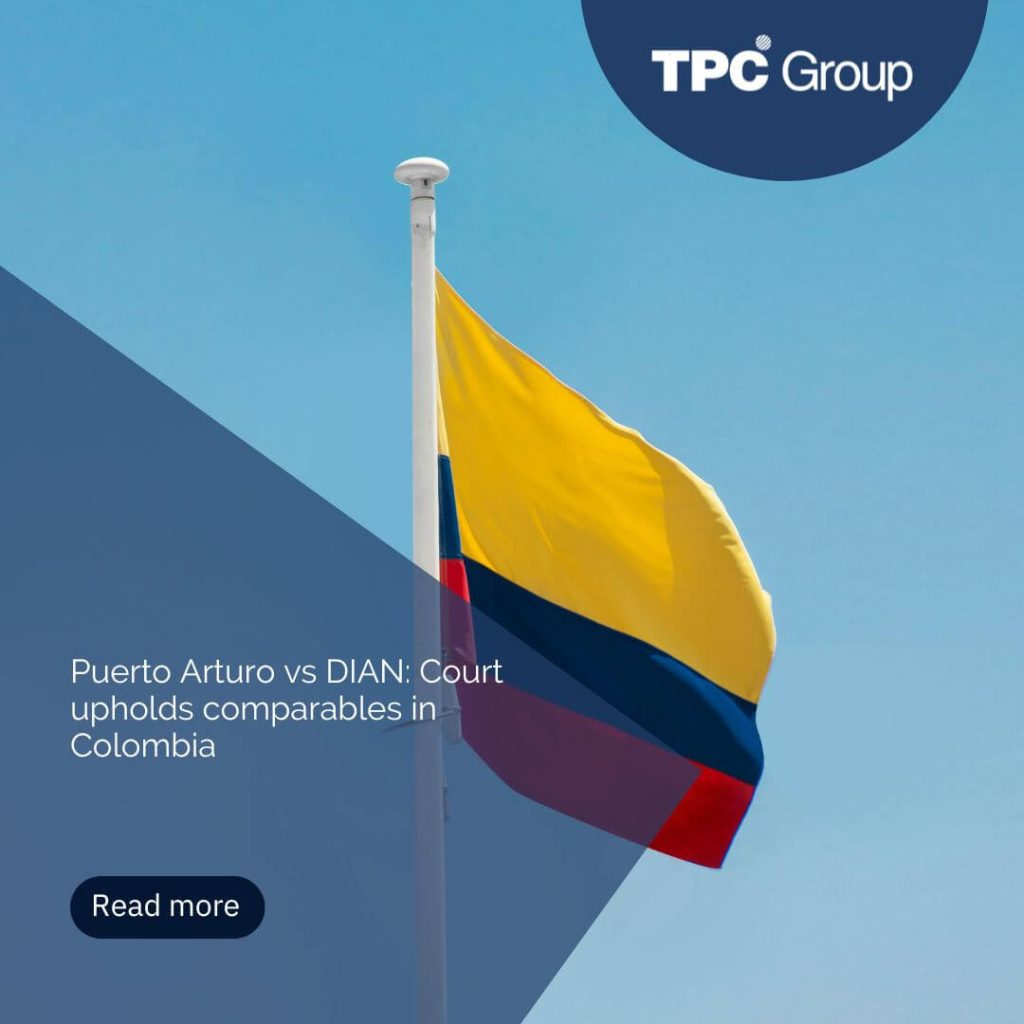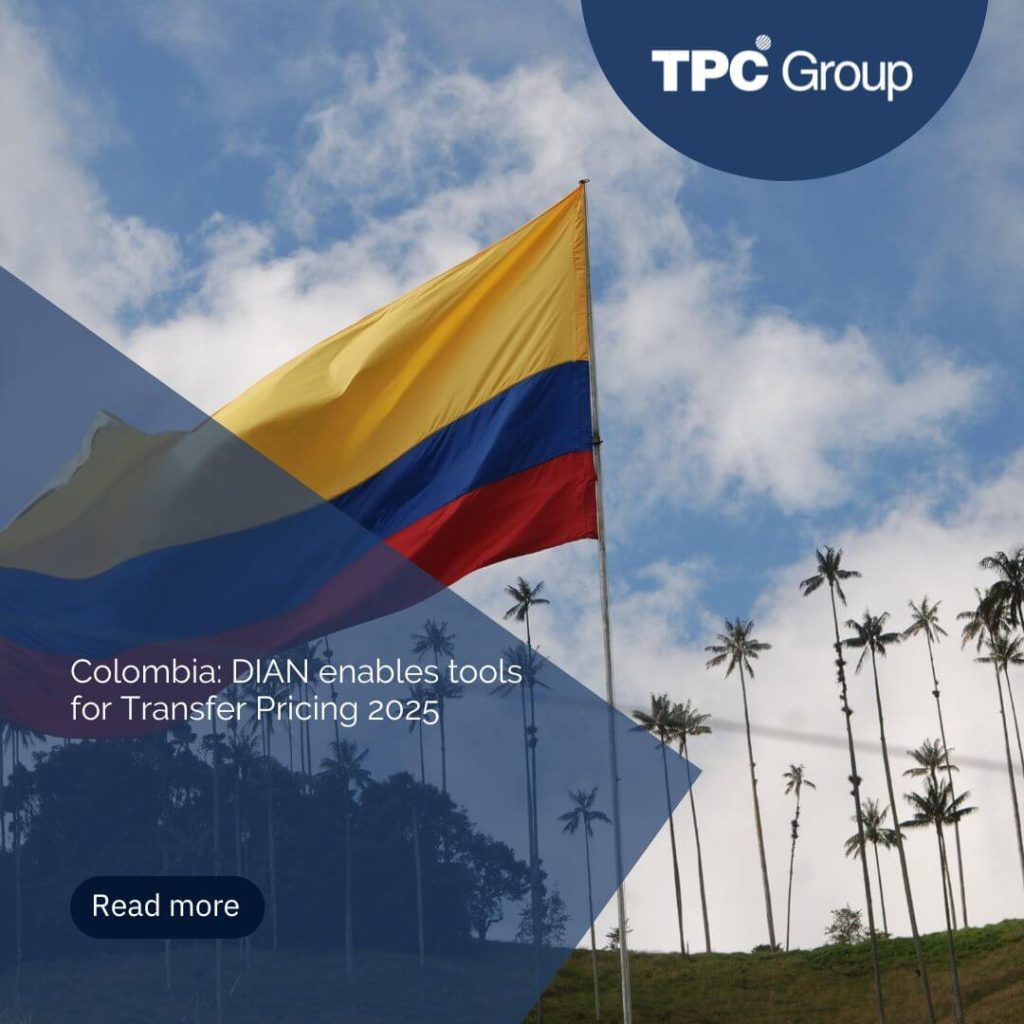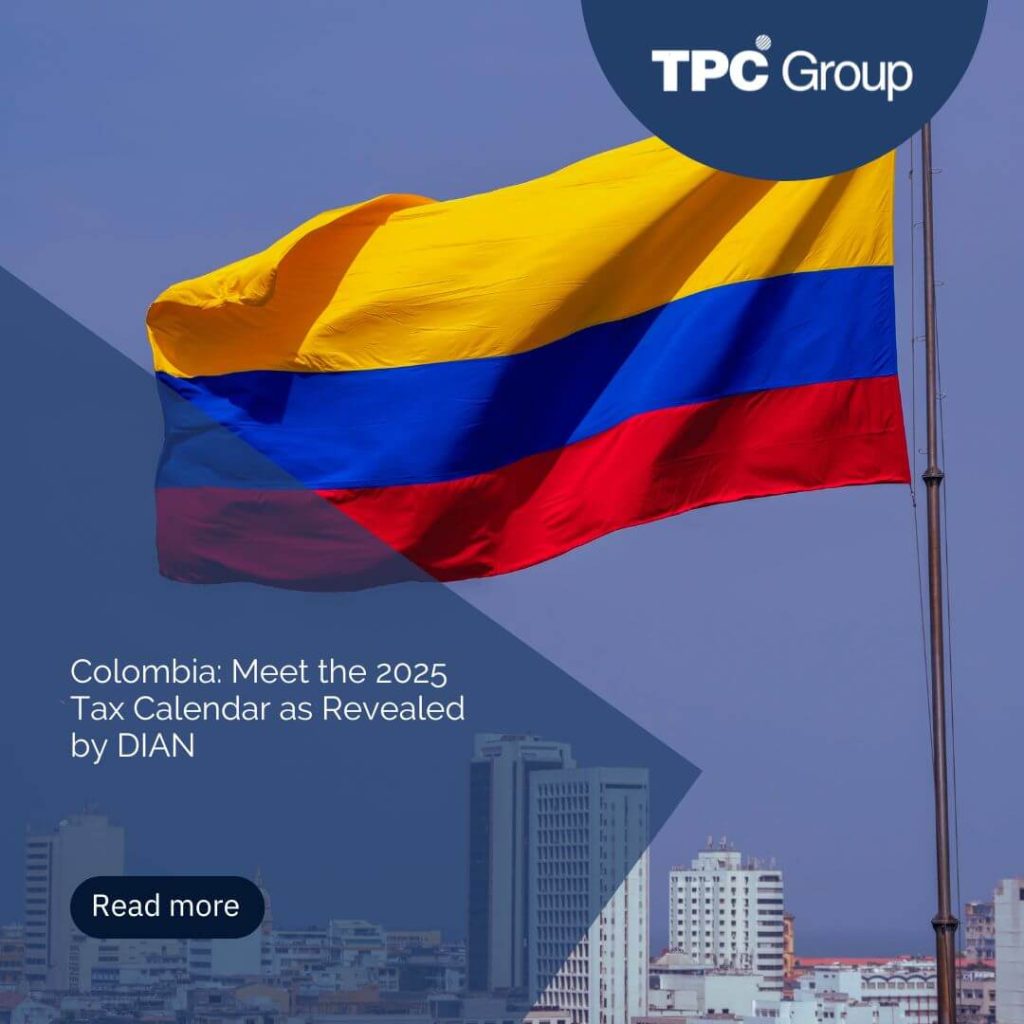Taxation and transfer pricing laws in Colombia
What are the transfer pricing regulations in Colombia?
Transfer Pricing in Colombia arose with Law No. 788 of 2002. Conversely, its legal framework was introduced by Decree No. 4349. Years later, in 2013, the Transfer Pricing regulations were significantly amended, for example, those related to formal obligations, such as the filing of the Informative Affidavit and the preservation of the proper supporting documentation.
Subsequently, Colombia continued amending the aforementioned Transfer Pricing regime to align with the BEPS (Base Erosion and Profit Shifting) plan of the Organization for Economic Cooperation and Development (OECD), focusing through the publication of Law No. 1819, on combating tax elusion or evasion.
In 2015, the DIAN published the “Guide for the Transfer Pricing Regime Availability,” which summarizes the legislation applicable to Transfer Pricing in three chapters.
As a result of the recommendations of the OECD BEPS 13 Action Report, incorporated in the OECD Transfer Pricing Guidelines, published in 2017, multinational companies must file the Supporting Documentation: The Master File – Transfer Pricing.
Additionally, multinationals whose ultimate controlling company is a tax resident in Colombia and have global revenues of UVT 81 million or more must file the Country-by-Country Report.
Arm’s Length Principle
The Arm’s Length Principle is based on prices agreed upon between related parties and considered at market value. Thus, these must be at the values agreed upon between independent parties and/or independent third parties. Consequently, the Arm’s Length Principle is set forth in Article 260-2 of the Tax Statute, defining it as the principle complied with in related party transactions similarly to those agreed upon in independent party transactions.
Transfer Pricing Application Situations in Colombia
Through Article 260-2 of the Tax Statute, Colombia regulates transactions carried out by individuals, companies, or entities located or resident in the Colombian territory with foreign related parties or those related parties domiciled in a free trade zone.
In addition, not only the aforementioned parties will be subject to compliance with the Transfer Pricing regime, but also the transactions carried out by taxpayers from, to, or through tax havens and/or territories of low or null taxation.
Related Parties: Transfer Pricing Relationship Criteria
The tax regulations indicate several criteria to consider related parties. Concerning the income tax and complementary taxes, the relationship criteria can be found below:
Subordinated Parties
- An entity will be subordinated or controlled when its decision-making power depends on the criterion of another person(s) or entity(ies) being its parent or controlling company, either directly, in which this will be considered a branch, either with the assistance or through the subordinates of the parent company, in which case this will be considered a subsidiary;
- A company shall be subordinated when it is in one or more of the following cases:
- i)When more than 50% of its capital belongs to the parent company directly, through, or with the assistance of its subordinates or theirs. Therefore, shares with preferential dividends and without voting rights shall not be included in the calculation;
- ii)When the parent company and the subordinated parties are jointly or separately entitled to cast the votes constituting the minimum decision majority in the shareholders’ meeting or the assembly or have the number of votes required to choose the majority of the members of the board of directors, if any;
- iii)When the parent company directly, through, or with the assistance of its subordinated parties, due to an act or business with the controlled company or its partners, influences the decision-making of the administrative bodies of the enterprise dominantly;
- iv)There shall also be subordination when the control under the assumptions set forth hereinis exercised by one or several individuals, legal entities, entities, or schemes of a non-corporate nature, either directly, through, or with the assistance of entities holding over fifty (50%) of the capital, constituting the minimum majority for decision-making, or influencing the management or decision-making of the entity dominantly;
- v) There will also be subordination when the same individual(s), legal entity(ies), or the same non-corporate vehicle(s) is (are) jointly or severally entitled to receive fifty percent of the profits of the subordinated company.
Branches regarding their main offices
Agencies regarding the corporations they belong to.
Permanent Establishments, regarding the company whose activity they carry out entirely or partially.
Other cases of Economic Relationship:
- a) When the transaction is carried out between two subordinated parties of the same parent company;
- b) When the transaction is carried out between two subordinated parties directly or indirectly belonging to the same individual, legal entity(ies), or schemes of a non-corporate nature;
- c) When the transaction is carried out between two companies in which the same individual or legal entity directly or indirectly participates in the management, control, or capital of both. An individual or legal entity may directly or indirectly participate in the management, control, or capital of another one when this:
- i) Directly or indirectly owns more than 50% of the capital of that company, or,
- ii) Can control the business decision-making of the company;
- d) When the transaction is carried out between two companies whose capital is owned directly or indirectly in more than fifty percent (50%) by persons related to each other by marriage, kinship up to the second degree of consanguinity or affinity, or civil relationship;
- e) When the transaction is carried out between related parties through unrelated third parties;
- f) When more than 50% of the gross income individually or jointly comes from its partners or shareholders, co-owners, associates, subscribers, or similar;
- g) When there are consortiums, temporary unions, joint accounts, and other forms of association not involving legal entities, as well as other business collaboration contracts.
The relationship applies to all the companies and vehicles or non-corporate entities comprising the group, even if their parent company is domiciled abroad.
-
Related parties in free zones
-
Transactions with non-cooperating, low, or no tax jurisdictions.
-
Preferential tax regimes
Non-Cooperating, Low, or Non-Existent Tax Jurisdictions and Preferential Tax Regimes in Colombia
The tax regulations refer to the Non-Cooperating, Low, or No Taxation Jurisdictions, assigning them special treatment for taxpayers performing business transactions in those territories. Thus, these will be given under certain aspects:
- Compared to the tax rates in Colombia, these are almost null.
- The total lack of exchange of information on tax matters, in addition to a lack of legal transparency.
Likewise, compliance with two of the aforementioned criteria will be decisive in discussing preferential tax regimes.
Transfer Pricing Methods in Colombia
The Colombian legislation, in Article 630-3 of the Tax Statute, establishes a total of 6 Transfer Pricing methods:
- Comparable Uncontrolled Price (CUP) Method
- Resale Price (RP) Method
- Cost Plus Cost (CP) Method
- Profit Split (PS) Method
- Transaction Net Margin Method (TNMM)
The taxpayer will be able to voluntarily choose the most suitable method for each transaction according to its interests.
- Breakdown of Transfer Pricing Methods
Comparability Criteria in Colombia
It is given when facing a comparable operation. In these cases, the following aspects must be considered:
- Details of the transactions.
- The assumed functions, pros, and cons of the transactions.
- The well-supported economic reality in the agreement conditions
- The economic context of the market.
- Business alternatives.
It should be noted that, for internal comparables, these should be immediately processed.
Documentation for Transfer Pricing Statements in Colombia
According to the Colombian DIAN (Dirección de Impuestos y Aduanas Nacionales – National Tax and Customs Directorate), the following are the types of Transfer Pricing reports:
- Information Statement (Form 120)
- Local Report
- Master File
- Country by Country Report
Information Statement (Form 120)
Definition
According to the Guide for the Transfer Pricing Regime Availability of the DIAN_404, issued by the DIAN:
An information statement is that through which the taxpayers of income tax and complementary taxes obliged to apply the rules regulating the Transfer Pricing regime and meeting the conditions to be declarants, notify the DIAN of the transactions they carried out during the taxable year with foreign-related parties, related parties located in Free Trade Zones, or with persons, corporations, entities, or companies located, resident, or domiciled in Tax Havens.
It is not a statement entailing the payment of any tax. Conversely, its late or inaccurate filing or its non-filing may lead to the payment of the penalties associated therewith.
Obligated Parties to File Form 120
The companies obligated to file the information statement are those meeting the following requirements:
- To be an income tax taxpayer during the fiscal period.
- To have entered into transactions with related companies, companies located in free zones, tax havens, or countries considered non-cooperating.
- To have a gross equity exceeding 100,000 Tax Value Units or gross income during the period exceeding 61,000 Tax Value Units.
These aforementioned requirements are established in articles 260-9, 260-1, and 260-2 of the Tax Statute:
- The main information to be contained in the statement
- Information necessary to identify the taxpayer
- Information to identify related parties
- Information on the types of transactions with their respective amounts.
- Information on the methodology employed for each transaction.
- Financial information of the tested company with its profitability indicator.
- Information on the found quartile in the analysis.
- Information on the adjustments made.
Information Statement Filing
The information statement must be filed through the 1125 format, also referred to as Prevalidator, which will generate a file in XML format. This file will be uploaded through the DIAN, and then the second part of Form 120 will be completed, in which the additional data requested will be filled in.
Local Transfer Pricing Report
Obligated Parties to File the Local Transfer Pricing Report
The parties obligated to file the supporting documentation must comply with the following requirements:
- To comply with the aforementioned information statement reporting requirements.
- To have carried out related party transactions for an amount exceeding 45,000 Tax Value Units, or alternatively, to have carried out transactions with non-cooperating jurisdictions for an amount exceeding 10,000 Tax Value Units.
The Main Information to Be Contained in the Local Transfer Pricing Report in Colombia
The local Transfer Pricing report must contain the data included in the information statement but with the evidencing transaction amounts, the methods employed, the income of the obligated company, and other functional information. The content of the supporting documentation shall be as follows:
- Executive Summary.
- Functional Analysis.
- Market Analysis.
- Economic Analysis.
Local Transfer Pricing Report Filing
The report shall be filed through the DIAN in PDF format under the 1729 format, i.e., change the name of the file to be declared and place it as follows: Dmuisca_ccmmmmmvvaaaacccccccc Where:
- cc : Concept (New = 01)
- (Replacement = 02)
- mmmmm : Format (Local Report) = 01729
- vv : Format version (Version= 07)
- aaaa : Reporting year = 2018
- cccccccc : Submission consecutive per year = 00000001
Master Transfer Pricing File
Obligated Parties to File the Master Transfer Pricing File
The parties obligated to file the supporting documentation must comply with the following requirements:
- To comply with the aforementioned local Transfer Pricing report filing requirements.
- To be a member of a multinational group.
“… belonging to multinational groups, defined as those consisting of two or more companies whose tax residence is in different jurisdictions, or which is composed of a company which is a tax resident in one jurisdiction and is taxed in another jurisdiction for the activities carried out through a permanent establishment.” The Main Information to Be Contained in the Master Transfer Pricing Report in Colombia. This report requests the general information of the Multinational Group to which the tested company belongs.
Master Transfer Pricing Report Filing
The report shall be filed through the DIAN in PDF format under format 5231, i.e., change the name of the file to be declared and place it as follows: Dmuisca_ccmmmmmvvaaaacccccccc Where:
- cc : Concept (New = 01)
- (Replacement = 02)
- mmmmm : Format (Master Report) = 05231
- vv : Format version (Version = 01)
- aaaa : Reporting year = 2018
- cccccccc : Submission consecutive per year = 00000001
Country-by-Country Transfer Pricing Report
What is the Country-by-Country (CbC) Report?
It forms part of Action Plan 13 of the BEPS initiative of the OECD, where the Parent or Controlling Entities of a Multinational Group must file an Annual Information Statement referred to as a Country-by-Country Report, which contains information related to the global allocation of income and taxes paid by the multinational group, along with certain indicators related to its business activity globally.
Must Colombian Companies Declare this Report?
Yes, they must. They are subject to certain terms as stated in Article 1.2.2.2.2.3.3.3 of Decree 1625 of 2016.
Who Must Declare?
- 1. Parent or Controlling Entities of Multinational Groups, defined as those meeting the following requirements:
- To be residents in Colombia.
- 2. To have affiliated companies, subsidiaries, branches, or permanent establishments that reside or are located abroad, as applicable.
- 3. Not be subsidiaries of another company located locally or residing abroad.
- 4. To be obligated to prepare, file, and disclose consolidated financial statements.
- 5. To have obtained the consolidated income for accounting purposes equal to or greater than eighty-one million (81,000,000) Tax Value Units in the immediately preceding taxable year or period.
- Entities resident locally or abroad designated by the parent or controlling entity of the multinational group resident abroad as a substitute entity thereof to file the Country-by-Country Report referred to in this Section on behalf of the Multinational Group with a permanent establishment in the country.
- One or more entities or permanent establishments resident or located locally belonging to the same multinational group, whose parent or controlling entity resides or is located abroad, and meeting the following requirements:
- 1. To have jointly an equity stake in the consolidated income of the multinational group equal to or greater than twenty percent (20%).
- 2. The parent company has not filed in its country of residence the Country-by-Country Report referred to in Article 1.2.2.2.2.3.5 of this Decree. It shall be considered to be those cases in which one of the following conditions is met:
- 2.1. There are no legal requirements binding the Parent or Controlling Entity of the Multinational Group to file the Country-by-Country Report in its jurisdiction of tax residence.
- 2.2. The jurisdiction in which the Parent or Controlling Entity resides for tax purposes has an effective “International Agreement” to which Colombia is a party but does not have a “Qualified Agreement between Competent Authorities” to which Colombia is a party on the filing date of the Country-by-Country Report for the Reported Fiscal Year; or
- 2.3. There is a “Systematic Non-Compliance” in the jurisdiction of tax residence of the Parent or Controlling Entity that has been notified by the Colombian Tax Administration to the Member Entity to the Multinational Group residing for tax purposes in Colombia.
- 3.The multinational group has obtained consolidated income for accounting purposes equal to or greater than eighty-one million (81,000,000) Tax Value Units in the immediately preceding taxable year or period.
If there is more than one entity with the above-mentioned requirements met, the entity or permanent establishment designated by the multinational group, or in its absence, the entity or permanent establishment with the largest equity in Colombia on December 31 of the taxable year to which the Country-by-Country Report corresponds, shall be responsible for filing the Country-by-Country Report.
When does It Not Apply?
When the Multinational Group, through a Substitute Entity designated by the former, has filed the Country-by-Country Report before the tax authority of the jurisdiction of its tax residence, no later than twelve (12) months counted as of the last day of the tax closing of the Multinational Group to which the Country-by-Country Report corresponds, provided that the following conditions are met:
- The jurisdiction of the tax residence of the Substitute Entity has the legal requirement to file the Country-by-Country Report, complying with the requirements set forth in article 1.2.2.2.2.3.5 of this Decree.
- The jurisdiction of the tax residence of the Substitute Entity has an effective Qualified Agreement between Competent Authorities of which Colombia is a party on the date foreseen to file the Country-by-Country Report.
- The jurisdiction of the tax residence of the Substitute Entity has not notified the Colombian Tax Administration of Systematic Non-compliance.
- The Tax Administration of the jurisdiction of the tax residence of the Substitute Entity has been notified by the Member Entity of the Multinational Group resident for tax purposes in such jurisdiction of which this is the Substitute Entity.
- The Member Entity of the Multinational Group resident for tax purposes in Colombia has notified the Special Administrative Unit of the DIAN (Dirección de Impuestos y Aduanas Nacionales – National Tax and Customs Directorate) of the identity and tax residence of the Reporting Entity.
When the consolidated income of the multinational group in the immediately preceding taxable year or period has not exceeded the income ceiling established in the jurisdiction of tax residence of the Parent or Controlling Entity of the Multinational Group to be obligated to file the Country-by-Country Report in such jurisdiction of the tax residence.
What Information Does It Contain?
According to the provisions of Section 3 of Article 1.2.2.2.2.3.3.5. of Decree 1625 of 2016, as amended by Article 2 of Decree 2021 of 2017, the CbC contains:
- Aggregate information related to the amount of revenues, income (loss) before taxes, income tax paid, income tax accrued, stated capital, retained earnings, number of employees, and tangible assets other than cash or cash equivalents regarding each of the jurisdictions in which the Multinational Group operates.
- Identification of each Member Entity of the Multinational Group, indicating the jurisdiction of tax residence of such entity.
Consequences of Non-Filing
According to the provisions of Article 1.2.2.2.2.3.7. of Section 3 of Decree 1625 of 2016: «Failure to comply with the provisions of numeral 2 of Article 260-5 and the provisions of Section 3 of this Chapter, shall be punishable, according to the provisions of Article 651 of the Tax Statute “Penalty for Failure to File Information or Filing Erroneous Information.»
Non-Compliance Penalties
Supporting Documentation Penalties
According to literal a) of Article 260-11 of the ET, among the penalties applicable to the supporting documentation are:
Late Filing Penalty
The late filing penalty will be applied when the supporting documentation is filed after the expiration of the deadlines decreed by the National Government, which will be determined according to the following criteria:
Filing within five working days following the expiration of the deadline for filing the supporting documentation shall result in a penalty of 0.05% of the total value of the transactions subject to be documented.
Filing after the five working days following the expiration of the deadline for filing the documentation shall result in a penalty of 0.2% of the total value of the transactions subject to be documented for each month or fraction of a calendar month of delay.
Inconsistency Penalty
This penalty applies for misinformation in the supporting documentation, non-correspondence of the information content with the requested, or the information does not allow to verify compliance with the Transfer Pricing regime. This penalty is equivalent to 1% of the transaction value for which the inconsistent information was provided.
Information Statement Penalties
Literal b) of Article 260-11 of the ET specifies each type of penalty applicable to the information Transfer Pricing statement. Among them, we emphasize:
Omission Penalty
This penalty arises from the omission of information regarding transactions subject to the Transfer Pricing regime. The amount of the penalty and the limit depend on the type of transaction carried out. Let us see:
- In transactions with economic-related parties: If the information statement totally or partially omits information related to transactions with economic-related parties, the penalty shall be 1.3% of the amount regarding which the information was omitted.
- In transactions with individuals, corporations, entities, or companies located, resident, or domiciled in tax havens: If the information statement omits information related to transactions with individuals, corporations, entities, or companies located, resident, or domiciled in tax havens, the penalty shall be 2.6% of the amount regarding which total or partial information was omitted in the information statement, in addition to the disregard of the costs and deductions derived from such transactions.
List of Tax Havens in Colombia
- Svalbard Archipelago
- Territorial Collectivity of Saint Pierre and Miquelon
- State of Kuwait
- State of Qatar
- Independent State of Western Samoa
- Queshm Island
- Pitcairn, Henderson, Ducie and Oeno Islands
- Solomon Islands
- Labuan
- Macau
- Commonwealth of the Bahamas
- Kingdom of Bahrain
- Hashemite Kingdom of Jordan
- Cooperative Republic of Guyana
- Republic of Angola
- Republic of Cape Verde
- Republic of the Marshall Islands
- Republic of Liberia
- Republic of Maldives
- Republic of Nauru
- Republic of Trinidad and Tobago
- Republic of Vanuatu
- Republic of Yemen
- Saint Helena, Ascension and Tristan de Cunha
- Sultanate of Oman





